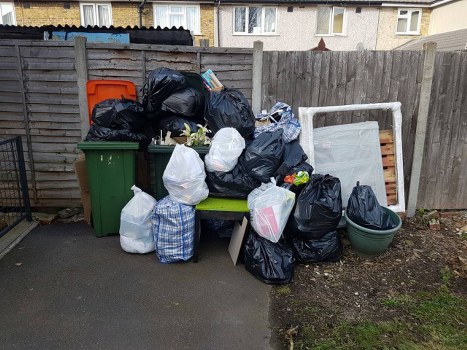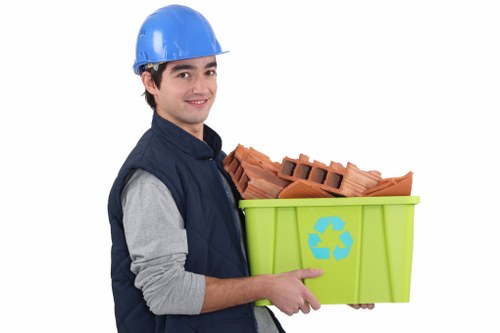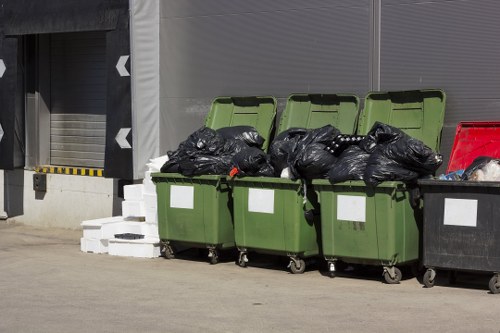House Clearances in Commercial Waste Disposal
Understanding House Clearances

House clearances are an essential component of commercial waste disposal. They involve the systematic removal of unwanted items from residential properties, making way for renovations, relocations, or estate management. Whether you're a business managing multiple properties or a waste disposal company offering comprehensive services, understanding the nuances of house clearances can significantly enhance your operations.
Effective house clearance not only ensures a clutter-free environment but also contributes to sustainable waste management practices. By responsibly disposing of household items, companies can minimize their environmental footprint and comply with local regulations.
In the realm of commercial waste disposal, house clearances play a pivotal role in maintaining the balance between operational efficiency and environmental responsibility. This article explores the multifaceted aspects of house clearances within the commercial waste disposal sector, providing insights into best practices, regulatory compliance, and the benefits of professional services.
The Importance of House Clearances in Waste Management

House clearances are more than just a cleanup task; they are a critical element of commercial waste disposal strategies. Proper clearance helps in:
- Reducing Waste Volume: Efficiently removing unwanted items decreases the overall waste that needs to be processed and disposed of.
- Promoting Recycling: Sorting and recycling usable items contribute to sustainable waste management practices.
- Ensuring Compliance: Adhering to local waste disposal regulations helps avoid legal penalties and promotes corporate responsibility.
- Enhancing Property Value: A well-maintained property free from clutter can increase its market value and appeal.
By integrating house clearances into their waste disposal programs, businesses can achieve a more organized, efficient, and environmentally friendly operation.
Moreover, house clearances can aid in disaster recovery and estate management, ensuring that properties are prepared and maintained appropriately.
Steps Involved in House Clearances

Conducting a house clearance involves several systematic steps to ensure thoroughness and compliance with waste disposal standards:
- Assessment: Evaluate the scope of the clearance, identifying the items to be removed and categorizing them for disposal or recycling.
- Planning: Develop a detailed plan outlining the timeline, resources needed, and methods for safe removal and transportation of waste.
- Sorting: Separate items based on their disposal requirements, ensuring recyclable materials are properly processed.
- Removal: Efficiently remove items from the property, minimizing disruption to the occupants or operations.
- Disposal: Transport the cleared items to appropriate facilities for recycling, donating, or landfill disposal in accordance with regulations.
- Final Inspection: Conduct a thorough check to ensure all unwanted items have been addressed and the property meets the desired standards.
Each step requires careful execution to ensure the clearance is performed effectively and responsibly.
Regulations and Compliance

Compliance with local and national waste disposal regulations is paramount in commercial waste management. House clearances must adhere to the following guidelines:
- Licensing: Ensure that all waste disposal activities are conducted by licensed professionals.
- Proper Segregation: Segregate waste according to type, ensuring recyclables are not mixed with general waste.
- Documentation: Maintain accurate records of waste disposal activities to demonstrate compliance during inspections.
- Environmental Protection: Avoid the disposal of hazardous materials unless permitted and handled by specialized services.
- Ethical Practices: Adopt ethical disposal methods, including donating usable items to charities or community organizations.
Staying informed about current regulations and continually training staff on compliance ensures that house clearances contribute positively to the company's waste management objectives.
Non-compliance can lead to significant fines and damage to the company's reputation, making adherence to regulations a critical aspect of house clearances.
Benefits of Professional House Clearance Services

Engaging professional house clearance services offers numerous advantages for businesses involved in commercial waste disposal:
- Efficiency: Experienced professionals execute clearances swiftly, saving time and resources.
- Expertise: Knowledgeable staff understand the best methods for handling various types of waste, ensuring safe and effective disposal.
- Cost-Effectiveness: Professional services can reduce overall waste management costs through optimized processes and bulk handling.
- Compliance Assurance: Experts ensure that all activities meet legal and environmental standards, mitigating risks.
- Customer Satisfaction: Providing reliable and thorough clearance services enhances client trust and business reputation.
By leveraging professional services, companies can focus on their core operations while ensuring that their waste disposal needs are met comprehensively.
Environmental Impact of House Clearances

House clearances, when managed correctly, have a positive impact on the environment. Key environmental benefits include:
- Resource Conservation: Recycling and donating items reduce the demand for new resources, conserving natural resources.
- Waste Reduction: Minimizing the amount of waste sent to landfills decreases greenhouse gas emissions and landfill overflow.
- Energy Savings: Recycling processes often require less energy compared to manufacturing new products from raw materials.
- Pollution Prevention: Proper disposal of hazardous materials prevents soil and water contamination.
Implementing sustainable house clearance practices aligns commercial waste disposal with broader environmental goals, fostering a greener and more sustainable future.
Additionally, companies can enhance their environmental stewardship by adopting innovative waste management technologies and practices.
Choosing the Right House Clearance Service

Selecting the appropriate house clearance service is crucial for effective commercial waste disposal. Consider the following factors when making your choice:
- Reputation: Research the service provider's track record and customer reviews to assess reliability.
- Services Offered: Ensure the provider offers comprehensive services, including sorting, recycling, and disposal.
- Compliance: Verify that the company adheres to all relevant regulations and holds necessary licenses.
- Pricing: Compare pricing structures to ensure cost-effectiveness without compromising on quality.
- Environmental Policies: Choose providers committed to sustainable practices and reducing environmental impact.
- Availability: Ensure the service provider can accommodate your schedule and project timelines.
By carefully evaluating potential service providers, businesses can ensure that their house clearance needs are met efficiently and responsibly.
Additionally, establishing a long-term partnership with a reliable provider can lead to streamlined operations and improved waste management outcomes.
Cost Considerations in House Clearances

Understanding the cost implications of house clearances is essential for budgeting and financial planning within commercial waste disposal operations. Factors influencing costs include:
- Volume of Items: The quantity of items to be cleared directly affects the overall cost.
- Type of Waste: Specialized disposal methods for hazardous or bulky items may incur additional charges.
- Location: Accessibility of the property and transportation distances can impact pricing.
- Service Level: Comprehensive services, including sorting and recycling, may be priced higher than basic clearance.
- Timeframe: Urgent or expedited services typically come at a premium.
To manage costs effectively, businesses should obtain detailed quotes, understand the pricing structure, and explore options for reducing expenses through efficient waste management practices.
Additionally, investing in preventive measures, such as regular maintenance and optimal storage solutions, can minimize the need for extensive house clearances.
Best Practices for House Clearances

Implementing best practices in house clearances ensures efficiency, compliance, and environmental responsibility. Key practices include:
- Comprehensive Planning: Develop a clear plan outlining the scope, resources, and timeline for the clearance.
- Proper Sorting: Categorize items for recycling, donation, or disposal to streamline the process.
- Safety Measures: Ensure that all safety protocols are followed to protect workers and occupants.
- Environmental Consideration: Prioritize recycling and donation to minimize landfill waste.
- Documentation: Keep detailed records of the clearance process for accountability and compliance.
- Continuous Improvement: Regularly review and refine clearance processes to enhance efficiency and sustainability.
Adhering to these best practices not only improves the effectiveness of house clearances but also supports broader waste management and sustainability goals.
Moreover, training staff on these practices ensures consistent and high-quality clearance operations.
Technological Innovations in Waste Disposal

Advancements in technology are revolutionizing commercial waste disposal, including house clearances. Innovative solutions such as:
- Waste Management Software: Facilitates efficient scheduling, tracking, and reporting of clearance activities.
- Automated Sorting Systems: Enhances the accuracy and speed of sorting recyclable materials.
- Eco-Friendly Vehicles: Reduces carbon emissions during waste transportation.
- Data Analytics: Provides insights into waste generation patterns and optimization opportunities.
- Mobile Apps: Enables real-time communication and coordination between teams and clients.
Integrating these technologies into house clearance processes can lead to increased efficiency, reduced costs, and a more sustainable operation.
Furthermore, staying abreast of technological trends allows businesses to remain competitive and responsive to evolving waste management challenges.
Sustainability and House Clearances

Sustainability is a core consideration in modern commercial waste disposal. House clearances contribute to sustainability through:
- Recycling Initiatives: Diverting materials from landfills by promoting recycling and reuse.
- Energy Efficiency: Implementing energy-efficient practices in waste handling and transportation.
- Reducing Carbon Footprint: Minimizing greenhouse gas emissions through optimized logistics and eco-friendly technologies.
- Community Engagement: Collaborating with local organizations to donate usable items and support community welfare.
- Resource Management: Efficiently managing resources to prevent waste and promote long-term sustainability.
Adopting sustainable house clearance practices aligns commercial waste disposal efforts with global environmental goals, fostering a responsible and ethical business model.
Additionally, sustainability initiatives can enhance the company's reputation and appeal to environmentally conscious clients and partners.
Challenges in House Clearances

Despite its benefits, house clearances in commercial waste disposal face several challenges:
- Logistical Complexities: Coordinating the removal and transportation of large volumes can be intricate and resource-intensive.
- Regulatory Compliance: Navigating diverse and evolving regulations requires continuous attention and adaptation.
- Waste Classification: Accurately sorting and classifying waste materials demands expertise and precision.
- Cost Management: Balancing quality service with budget constraints can be challenging.
- Environmental Concerns: Ensuring that clearance activities do not negatively impact the environment requires diligent practices.
- Client Coordination: Managing client expectations and schedules adds another layer of complexity.
Addressing these challenges requires strategic planning, skilled personnel, and a commitment to continuous improvement.
By proactively identifying and mitigating potential obstacles, businesses can enhance the effectiveness and reliability of their house clearance services.
Future Trends in Commercial House Clearances

The future of house clearances in commercial waste disposal is poised for significant transformation, influenced by factors such as:
- Increased Automation: Greater use of automated systems for sorting and processing waste will enhance efficiency.
- Green Technologies: Adoption of eco-friendly technologies will drive more sustainable clearance practices.
- Data-Driven Decisions: Enhanced data analytics will enable better forecasting and waste management strategies.
- Circular Economy: Emphasis on reusing and repurposing materials will become more prevalent.
- Regulatory Enhancements: Stricter environmental regulations will necessitate more robust compliance measures.
- Customer-Centric Services: Personalized and flexible clearance solutions will cater to diverse client needs.
Staying ahead of these trends will enable businesses to offer cutting-edge house clearance services, maintaining competitiveness and ensuring long-term sustainability.
Additionally, embracing innovation will facilitate the development of more efficient and environmentally responsible waste disposal practices.
Case Studies: Successful House Clearances

Examining successful house clearance projects provides valuable insights into effective strategies and best practices. Consider the following examples:
- Large-Scale Renovation: A commercial property undergoing extensive renovations required a comprehensive house clearance. By implementing a phased clearance approach and leveraging advanced sorting technologies, the project was completed efficiently, minimizing downtime and ensuring compliance with waste disposal regulations.
- Estate Management: Managing the clearance of multiple estates simultaneously posed logistical challenges. A coordinated effort involving detailed planning, resource allocation, and real-time tracking systems ensured that all clearances were executed smoothly and within budget.
- Disaster Recovery: In the aftermath of a natural disaster, prompt house clearances were essential for recovery efforts. Utilizing scalable services and flexible scheduling enabled rapid response, facilitating the swift restoration of affected properties.
- Commercial Relocation: A business relocating its offices required a seamless house clearance to transition smoothly to the new location. Professional services ensured that all items were handled with care, prioritizing reusable and recyclable materials to support sustainability goals.
These case studies highlight the importance of strategic planning, adaptability, and the use of professional services in achieving successful house clearances.
Learning from these examples can help businesses refine their own house clearance processes, ensuring efficiency and reliability.
Conclusion

House clearances are a vital aspect of commercial waste disposal, offering numerous benefits including enhanced efficiency, environmental sustainability, and regulatory compliance. By understanding the intricacies of the clearance process, adhering to best practices, and leveraging professional services, businesses can effectively manage their waste disposal needs.
As the industry evolves, embracing technological advancements and sustainable practices will be crucial in maintaining competitiveness and fostering a greener future.
For businesses seeking to optimize their waste management operations, partnering with experienced house clearance providers is a strategic move towards achieving operational excellence and environmental responsibility.
Contact us today to learn how our professional house clearance services can support your commercial waste disposal needs.